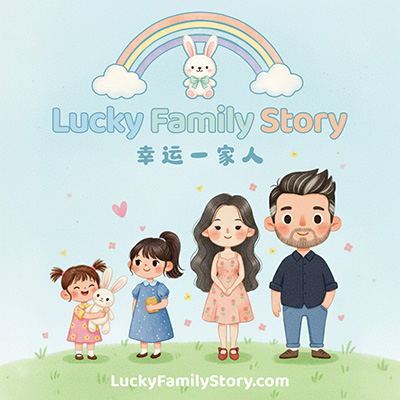As a dad, bedtime stories are one of my favorite parts of the day. Every night, my two girls — Luna and Kina — would snuggle in with their stuffed bunny Tutu and ask for “just one more story.”
Over time, those stories started to grow — little moments from our daily life turned into imaginative adventures about family, kindness, and curiosity. Eventually, I realized I didn’t just want to tell these stories… I wanted to create them.
That’s how Lucky Family Story began — a bilingual picture-book and short-video series inspired by our real family moments.
🧠 The Idea
I wanted each story to feel cozy and heartfelt, but also be simple enough for toddlers learning English or Chinese. So I started writing short scripts — one sentence per page — introducing words like Mommy, Daddy, hug, and pumpkin through small family adventures.
These books aren’t just teaching language — they’re teaching connection, patience, and imagination. And behind the scenes, they’ve also become an experiment in how AI can empower creativity.
🤖 My AI Toolchain: Turning Ideas Into Art
Creating a consistent illustrated world used to require a full art team. Now, with the right tools, one person can do it — carefully, thoughtfully, and with a lot of love.
Here’s how I built the process:
ChatGPT — my co-author and creative partner. It helps me brainstorm story ideas, structure scripts, and even translate lines between English and Chinese. It’s like having an endlessly patient editor who never sleeps.
Scenario — this is where the characters come to life. I trained custom models for each family member — Daddy, Mommy, Luna, Kina, and Tutu — so they look consistent across every scene. It’s what makes the Lucky Family feel like one world.
Adobe Photoshop — still the heart of the process. Every page gets polished here — lighting, composition, details. AI can generate a scene, but Photoshop gives it warmth, texture, and emotion.
Gemini — my “touch-up wizard.” It’s perfect for those small, human tweaks: adjusting a facial expression, moving a hand slightly, or changing the direction of a glance. It’s like fine-tuning the emotion in each frame.
Together, these tools create a kind of creative orchestra — AI helps with consistency and iteration, while I focus on storytelling, feeling, and visual rhythm.
💡 What I’ve Learned
Working on Lucky Family Story has taught me that AI isn’t replacing creativity — it’s expanding it. The tools don’t tell me what to make; they help me make what I already see in my head.
And the best part? My girls now watch the finished stories and say things like, “That’s me!” or “Daddy made that!” It’s a loop of imagination that keeps growing — from bedtime giggles to bilingual books and animated videos.
✨ What’s Next
We’re releasing the stories on YouTube, 小红书, and TikTok, one cozy adventure at a time. From carving pumpkins to going potty, every story captures a little truth about growing up — and about being a family.
If you’re a parent, artist, or AI tinkerer curious about how technology can make creativity more personal, follow along. I’ll be sharing behind-the-scenes posts about the process — from storyboarding and character design to video production.
This project is for my kids, but it’s also a love letter to creativity itself — a reminder that art and technology can work hand-in-hand to make something warm, human, and real.
